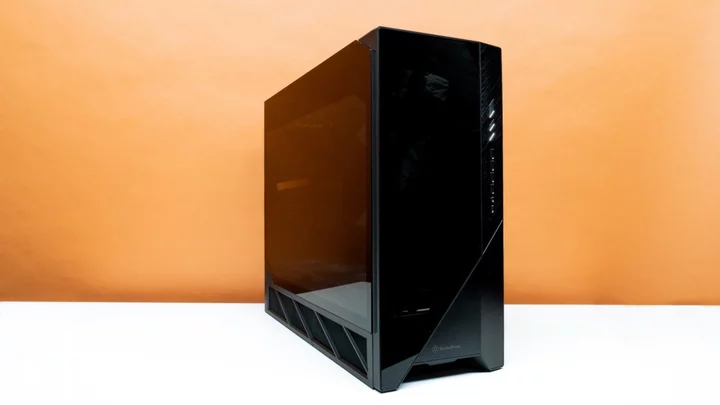At nearly two feet high and more than two feet deep, the titanic SilverStone Alta F2 is not a chassis you can lose in any lineup of PC cases—it’s very much its own colossus. This space-devouring $999 mega-case is big in every dimension, and it flaunts almost every convention. You can install your video card upright at a canted angle. And your motherboard mounts, in classic SilverStone style, rotated 90 degrees, with the ports facing upward.
We're not quite sure who the perfect buyer for SilverStone’s top-end full-tower might be—we're pretty certain they're rich, though. This case will eat for lunch the most amped-up PC configuration you can imagine or afford, and munch the rest of your budget for a snack. It's a superb performer and a heck of a looker, but also overkill personified: For most folks, the price makes the Alta a supercar-style lust object versus a realistic PC case pick.
The Design: Outsize Opulence
Consider just the Alta F2’s 46.5-pound weight empty to understand that this case is going to be a little over the top: Many of our full test builds, with all components in place, weigh less! In parallel with the gargantuan size, SilverStone spared little expense on glitz, with its combination of brushed and matte anodized aluminum face inserts, extra-dark tempered glass, and textured finish.
(Credit: Joseph Maldonado)You'll find the case's front-panel connections on the actual front panel: four USB 3.2 Type-A (Gen 1) ports, one USB 3.2 Type-C (Gen 2x2), and a headset/microphone combo jack. Power and reset buttons above those ports feature power-on and hard drive activity LEDs.
(Credit: Thomas Soderstrom)As the Alta supports motherboards even larger than Extended ATX (EATX), your first surprise might be that the back panel has only four expansion slots (dressed up via a removable plastic plug) at a jaunty angle. These slots accommodate your video card, mounted vertically; the quirky angling is, according to SilverStone, a bit above 10 degrees and the best-case scenario for cooling airflow, per the company's tests. Also back here are two push-button side-panel latches and a grab handle. The lack of a motherboard I/O section is your first indication that the Alta F2 uses the rotated-motherboard design first introduced by SilverStone a dozen years ago.
(Credit: Joseph Maldonado)Zooming in on the grab handle reveals nothing less than a power-supply mount behind it, or we should say, ahead of it, since the hole is on the rear panel. The space above the power supply mount is capped with a thick, vented aluminum plate.
(Credit: Joseph Maldonado)The top plate is a proper exhaust vent, lacking any dust filters. (Filtering air as it exits the case has never made much sense, but many chassis makers put a filter up here regardless, in the event you use this as an intake.) It’s attached by small permanent magnets that are glued into countersunk holes around its periphery.
(Credit: Joseph Maldonado)The Alta keeps with the rotated theme when opening the glass side panel: Here, we see a power supply tunnel that runs vertically along the rear edge, behind the motherboard tray. A small bracket atop the power supply tunnel is designed to secure PCI Express extension cables for the rear-panel alternative graphics card mount, and a 2.5-inch drive tray resides in the tiny space under the lower end of the power supply tunnel.
(Credit: Joseph Maldonado)Viewing the same space from the other direction, we see two dual-3.5-inch drive cages mounted (also at an angle) to the back side of the front panel, plus three 180mm intake fans that draw air upward from a fully filtered bottom chamber.
(Credit: Joseph Maldonado)Countersunk, glued-in magnets hold each of the lower chamber’s dust filters in place, while a regular filter sheet is applied to the inside of the side panel vent (for the power supply) via magnetic strips.
(Credit: Thomas Soderstrom) (Credit: Thomas Soderstrom)With those details out of the way, it’s time to reveal the motherboard chamber in its full glory. The interior is designed to situate the motherboard’s I/O panel (that is, the traditional "back" panel) on top and its "front" edge at the bottom. SilverStone describes the vastness of this space by referencing the outdated XL-ATX standard (which adds up to 1.8 inches to the bottom of the board), in addition to the EATX standard. (It adds up to three-quarters of an inch of space to the forward edge of the motherboard.) You won't find any reasonable motherboard that doesn't fit here. Most unreasonable ones should, too.
(Credit: Thomas Soderstrom)Viewing this space from the other side, we see two 2.5-inch drive trays attached to the back of the motherboard tray up top, and two dual-drive trays stuffed inside the intake area beneath the motherboard chamber. Each of the lower trays has two sets of four vibration-damping grommets on 3.5-inch drive mount spacing, plus a set of 2.5-inch mounting holes inside the 3.5-inch spacing.
(Credit: Thomas Soderstrom)The 2.75 inches of space between the motherboard’s I/O panel and the Alta F2’s top panel provides room to bend cables over. In the finished build, you’ll route cables through the rear panel’s handhold hole to reach those ports.
(Credit: Joseph Maldonado)A look at the uncovered top panel might clarify things a little (below), as you’ll see the previously viewed power-supply mount at the back of it and the open motherboard I/O panel rectangle near its front. Nine expansion slots in a row help to explain why SilverStone referred to eight-slot XL-ATX sizes, and we even see a four-slot alternative slot bracket next to the power supply mount. So that makes three ways to mount your video card…or does it?
(Credit: Thomas Soderstrom)Big Cooling is one of the big reasons why builders with big expectations might buy a big case like this, but with this chassis’ relatively small dual-fan mount up front and all the slots on top, it may not immediately be apparent that the Alta F2 is even designed to hold a large radiator. But behold: It has most of the mounts for a four-by-120mm (480mm-format) top panel radiator. Putting one here requires ditching the four-space removable slot panel next to the power supply, but that’s one of the reasons that the panel is, indeed, removable. The only problem remaining is that top panel radiators block all nine normally placed (in relation to the motherboard) expansion slots.
(Credit: Thomas Soderstrom)Meanwhile, the bottom panel, SilverStone claims, can take up to a 540mm or 560mm radiator, but those sizes are completely beyond our experience. Alternately, a radiator may be placed above the bottom's three intake fans, but we’ll need to cover a bit of the installation kit to explain how.
Accessories and Cabling: Quite the Excess
In keeping with its size and install flexibility, the Alta F2 includes one heck of an accessory kit. First is a radiator-adapter bracket that fits a three-by-140mm (420mm-format) or four-by-120mm (480mm-format) radiator over its triple 180mm intake fans. You also get a bracket to adapt the two-by-140mm front panel mount to hold two-by-120mm radiators, plus a pair of brackets to support long graphics cards when mounted sideways to the rear panel. Also in the box: a power supply adapter for the top panel’s removable four-slot bracket, a triple-fan splitter for a single motherboard fan header, a bundle of cable ties, and a rubber damper and two thumb screws for the card support bracket.
(Credit: Thomas Soderstrom)Then there’s the rest of the screws and related fastener items: a Phillips #2 drive adapter socket for hexagonal motherboard standoffs, a pack of 12 motherboard standoffs, a bag of #6-32 screws to hold the motherboard to its standoffs and 3.5-inch drives in the front-mount drive cages, a bag of M3 screws for 2.5-inch drives, a bag of shoulder screws for mounting 3.5-inch drives to the grommet-damped holes of the lower drive trays, and a bag of coarse-threaded screws for securing plastic fans.
The PC industry has started to use the term “Type E” as the official name of the Gen 2x2-supporting cable that leads to the Alta F2’s front-panel USB 3.2 Type-C port. Most mainstream and higher-end modern motherboards now have this Type E connector. Moving over to the 19-pin cables that feed the four Type-A ports, that’s a different situation: Most of the boards that have two of these are more upscale than the ones we use for case evaluation. Of course, you had better be putting an upscale board in a luxury-model case like this...we hope!
(Credit: Thomas Soderstrom)The front-panel headset combo jack connects via the HD Audio cable, and the front panel button/LED group is bundled as three pairs and two singles despite an industrywide effort to adopt Intel’s decades-old nine-pin layout.
Building With the Alta F2
Now, we finally get to reveal the enormity of the Alta, by way of comparison: The full-ATX motherboard shown is 12 inches from left to right in this photo, as its bottom edge is on the left and its top edge is on the right. It looks like a Mini-ITX board in this case!
(Credit: Thomas Soderstrom)Old XL-ATX boards would fill some of the empty space between our board’s bottom edge and the power supply tunnel at the rear, while EATX boards would fill most of the space between the three intake fans and our ATX motherboard. Our GeForce RTX 2070 card is far too small to even need the included support bracket, though today’s top cards tend to be 3 to 4 inches longer. Noticing how ungainly the extension cable appears, we assume that this is part of the reason SilverStone picked so dark a tint for the side panel glass.
We wouldn’t even have put the graphics card on the angled rear mount if not for the radiator of our AIO cooler preventing us from installing the card directly into the motherboard’s slot. While it certainly looks good in that location, putting it there simply wouldn’t have been a necessary part of this test had the radiator and graphics card been able to coexist at the top of the case.
(Credit: Thomas Soderstrom)You see, we couldn’t put our radiator on the bottom panel because its air bubble would have ran upward, into the pump. And we didn’t want to put it on the front panel because that area doesn’t appear to be as well ventilated. Furthermore, most of our previous PC case reviews have used the radiator’s fans to pull heat off the motherboard’s CPU voltage regulator, and we didn’t want to put the Alta F2 at a disadvantage in that regard.
Testing the Alta F2: Hugely Cool
Below is a rundown of the test hardware we installed in the Alta F2. We stacked it up against the numbers we saw from some of the biggest, baddest cases we've tested in the last few years, among them the Asus ROG Hyperion GR701, the Cooler Master HAF 700, and the In Win Airforce.
It is probably because its intake fans push so much air, but the Alta F2 produced the lowest CPU temperatures we’ve seen from this platform. It barely edges out the former champion from HP, the Omen 45L ATX case, but it’s still a win.
(Credit: PCMag)Should we have been concerned about the impact of moving our AIO cooler’s fans away from the voltage regulator? Going by the Alta F2’s winning voltage-regulator temperature, apparently not.
(Credit: PCMag)Putting our graphics card in its more visible, slightly tilted location didn’t help it dominate on thermal readings, but it did finish in a three-way-tie among the NZXT and Asus samples for third place. Mind you, it looked great doing it.
(Credit: PCMag)One nice thing about big, thick fans is that they can move much air at little noise. The Alta F2 also uses its glass face and side panel to reflect most of the noise from our graphics card back into the case: The steel right-side panel doesn’t contain noise as well, but the Alta F2 is still quieter when measured from this corner than its rivals.
(Credit: PCMag)Verdict: A Mighty Fortress for Your Parts
Between its superior cooling and moderate noise levels, the Alta F2 may not even need to justify its price for some of the PC building market’s spendier buyers. And that’s a good thing for its maker, because we really can’t come up with a good way to justify, in a practical sense, spending a kilobuck on any PC case, as nice as this one is.
We might say “more radiator support,” but we’ve never actually seen a 480mm radiator, and we’ve already reviewed far cheaper cases that support 420mm ones. We might say "more performance," but a few degrees shaved off a thermal chart are hard to justify against a multiplication factor in price. And we might say "more space," but most shoppers will run out of cash before they run out of parts to add here.
Still, sometimes "more bragging rights" is the answer. Rather than consider the Alta F2 an exorbitantly priced collection of expensive features, think of it a solution for a specific builder who has a specific goal in mind, and doesn’t let little details like price get in the way. Also think of this investment-grade box as the last PC case you'll ever need to buy in your lifetime.









